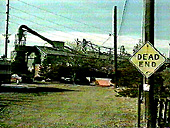![]()
![]()
![]()
![]()
![]()
![]() Equity
Within Nations
Equity
Within Nations
![]() •
Proximity to
problems
•
Proximity to
problems
![]() Inequities
leading to problems
Inequities
leading to problems
![]() Impacts
of measures
Impacts
of measures
![]() Inequity
in decision making
Inequity
in decision making
![]()
![]()
![]() Equity
Between Nations
Equity
Between Nations
![]() International
Economic System
International
Economic System
![]() Global
Warming and Equity
Global
Warming and Equity
![]() References
References
![]() Site
Map
Site
Map
![]()
|
Poorer people tend to suffer the burden of existing environmental problems more than others do. This is because more affluent people have more choices about where they live: they can afford to pay more to live in areas that have not had their environment degraded. Also, more affluent people are better able to fight the imposition of a polluting facility in their neighbourhood because they have better access to financial resources, education, skills and the decision-making structures. This is particularly obvious in some countries where shanty-towns are found. These are generally located in areas where the better off do not want to live&emdash;near garbage dumps or hazardous industrial facilities or in areas prone to flooding, landslips and other dangers. However, this situation is not confined to low-income countries. In the USA: "The poorer the neighbourhood, and the darker the skin of its residents, the more likely it is to be near a toxic waste dump. Three fourths of hazardous waste landfills in the American Southeast are in low-income, black neighbourhoods, and more than half of all black and Hispanic Americans live in communities with at least one toxic waste site. As in the United States, so in the Third World: the rich get richer, and the poor get poisoned." (Durning 1990, p. 147) Robert Bullard, a US sociologist, undertook a study in Houston, Texas. He found that all five city council landfills, three out of four private landfills, and six out of eight garbage incinerators were sited in black neighbourhoods&emdash;although blacks made up only 28 per cent of the population. Throughout the USA, 68 per cent of black children from families making $6000 per year or less suffer from lead poisoning, compared with 36 per cent of white children from families in the same income bracket. Of families making $15 000 per year or more, 38 per cent of black children suffer lead poisoning compared with 12 per cent of white children. Bullard argues that this is evidence of environmental racism. Valerie Taliman, a member of the Navaho nation, also uses the term 'environmental racism' when she describes the way that Indian reserves are being used to dispose of hazardous wastes. She claims that in the last two years more than fifty Indian tribes have been approached by waste disposal companies offering millions of dollars in return for allowing them to locate these hazardous waste facilities on their land. Indian reserves are not subject to as many environmental regulations as are usual in the USA. In Australia, people living in the cities tend to be most affected by pollution, noise and the threats of chemical contamination and accident, although pollution and exposure to agricultural pesticides can be a problem in some rural areas. Urban problems arise from the concentration of industries, people and cars, and the lack of open green spaces. The impacts of environmental problems are not evenly distributed within cities. Often, the impacts are determined by where people live. People living near or in industrial areas are more likely to suffer from air or water pollution. People living under a flight path or near a main road are more likely to suffer from noise. People in the inner suburbs are more likely to suffer from urban decay and traffic problems. People living in the outer suburbs are more likely to suffer from lack of provision of urban infrastructure and community facilities. Impacts can also be determined by other factors such as age, gender, income and health status. For example, people with existing respiratory problems may be affected more by air pollution; while the very young or the very old may be more vulnerable to environmental pollution in general. For example, Jim Falk and his colleagues point to places in Metropolitan Adelaide where deaths from respiratory diseases seem to be correlated with failure to meet air quality standards and where 'overlaying the map of factory emissions onto the distribution of clients of meals on wheels shows that there is a captive population which cannot easily move away from close proximity to potentially toxic emissions' (Falk et al. 1993, p. 54). In areas in the Hunter Valley and the Illawarra region, levels of lead and sulphur dioxide in the air often exceed air quality goals set by the National Health and Medical Research Council (ESD Working Groups 1991a, p. 29). Another variation on the same theme is the way workers in certain industries are often exposed to higher health risks than the rest of the community&emdash;as, for example, are workers in mining or mineral processing and the chemical industry. Often, the work-forces in very hazardous industries are made up of large numbers of migrants who have fewer choices about their work when they first come to Australia. In the case of asbestos and uranium mining, there is a high proportion of Aboriginal workers who have little power to negotiate better working conditions.
Source: Sharon Beder, The Nature of Sustainable Development, 2nd edition, Scribe, Newham, Vic.,1996. |
 Proximity
to Environmental Problems
Proximity
to Environmental Problems